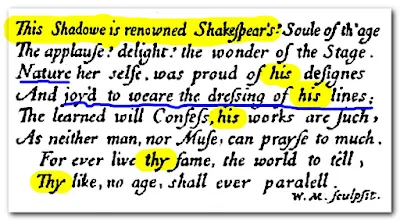Contemporary Indications for a „historic“ authorship Issue
The book "POEMS: VVRITTEN BY WIL. SHAKE SPEARE. Gent." entered the Stationers' Register on November 4, 1639. -
It is noteworthy that the printer Thomas Cotes also printed the Second Folio (1632), and![]() Q1 of The Two Noble Kinsmen (1634).
Q1 of The Two Noble Kinsmen (1634).
William Marshall's pictorial representation of Shakespeare was attached to the book
It is noteworthy that the printer Thomas Cotes also printed the Second Folio (1632), and
William Marshall's pictorial representation of Shakespeare was attached to the book
(s. also next Blog)
as a reduced and reversed version of Martin Droeshout's engraving from the First Folio, followed by 8 lines explaining the picture. -
Image and subtext must be interpreted as a farce, which is only understandable if one is aware of the authorship problem: the true poet-dramatist (former Marlowe - still alive) wrote under pseudonyms such as "Shake-speare" borrowed from a living man named Shakspere..
Some notable conspicious points of the farce:
1) Illustrated is the reversed, mirrored man of the First Folio (" the false Shakspere")
2) The text is written by the editor, a certain John Benson, a mirrored man of dead, former Ben Jonson (Did a "John Benson" exist in reality?)
3) The illustrated man is deliberately depicted not as a poet, (usually characterized laurel-wreathed around the front head,
4) The illustrated man is only holding the laurel in his gloved hand, thus beeing a place holder for the poet...
5) Usually a bare hand hold the gloves....(s.Ben Jonson)
6) The man himself (illustrated) is not renowned but his Shadow
7) Deliberately the Shadow is not - as usual - darker but more bright (yellowed!)
8) Nature (The Stratford man, Shakspere) was proud of his outer design he gave to another, a man of Art (the"true Shake-speare")
9) Nature (The Stratford man, Shakspere) enjoyed to wear the dressing of the lines of another, the true poet (Marlowe alias Shake-speare )
10) The fame of the "true" poet is his alike , (not the man), his fame will live forever.-
There is a clear distinction between the genius, his achievements (his designes, his lines, his works) and the others fame, (thy fame) the others "likeliness" (Thy like)
Image and subtext must be interpreted as a farce, which is only understandable if one is aware of the authorship problem: the true poet-dramatist (former Marlowe - still alive) wrote under pseudonyms such as "Shake-speare" borrowed from a living man named Shakspere..
Some notable conspicious points of the farce:
1) Illustrated is the reversed, mirrored man of the First Folio (" the false Shakspere")
2) The text is written by the editor, a certain John Benson, a mirrored man of dead, former Ben Jonson (Did a "John Benson" exist in reality?)
3) The illustrated man is deliberately depicted not as a poet, (usually characterized laurel-wreathed around the front head,
4) The illustrated man is only holding the laurel in his gloved hand, thus beeing a place holder for the poet...
5) Usually a bare hand hold the gloves....(s.Ben Jonson)
6) The man himself (illustrated) is not renowned but his Shadow
7) Deliberately the Shadow is not - as usual - darker but more bright (yellowed!)
8) Nature (The Stratford man, Shakspere) was proud of his outer design he gave to another, a man of Art (the"true Shake-speare")
9) Nature (The Stratford man, Shakspere) enjoyed to wear the dressing of the lines of another, the true poet (Marlowe alias Shake-speare )
10) The fame of the "true" poet is his alike , (not the man), his fame will live forever.-
There is a clear distinction between the genius, his achievements (his designes, his lines, his works) and the others fame, (thy fame) the others "likeliness" (Thy like)
________________________________



